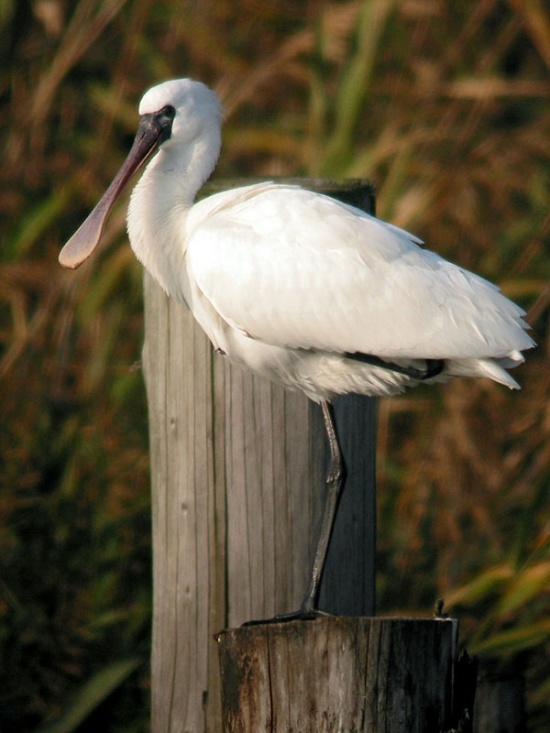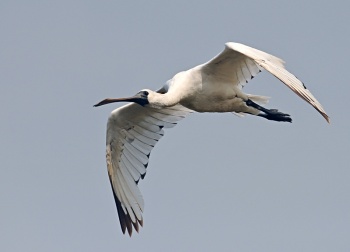- Platalea minor
Identification
60–78½ cm (23¾-30¾ in)
Adult: smallish, white spoonbill with blackish bill and wide bare black lore skin. Breeding plumage has yellowish band across upper breast and nape plumes which vary from yellow to white. Immature is similar to winter adult but has black primary tips and feather shafts.
Similar species
The Eurasian Spoonbill P. leucorodia is larger, has yellow tip to bill and narrower black lore stripe.
Distribution
Formerly widespread in East Asia, this endangered species now has the most restricted range of any spoonbill. Platalea minor breeds on islets off the west coast of North Korea and South Korea, and Liaoning province in mainland China. Birds have been reported in the Tumen estuary of Russia, but breeding has not been proven.
The three major wintering sites are the Tsengwen estuary of Taiwan (China) (562 individuals), the Deep Bay area of Hong Kong (China) (179 individuals), and the Red River delta, Vietnam (65 individuals). It also winters in Cheju, South Korea, Kyushu and Okinawa, Japan, and Yancheng and Hainan, China, and there are recent records from Thailand, the Philippines and Macau (China).
Satellite tracking has shown that birds wintering in Hong Kong and Taiwan migrate along the coast of eastern China to northern Jiangsu, then over the Yellow Sea to the Korean peninsula.
A minimum of 1069 individuals were counted by the 2003 International Black-faced Spoonbill Census, 10% more than in 2002. At its low point, the world population was down to just over 200 birds, but it now appears stable at over 1600 adults.
- Status update
As of 2022, the world population of Black-faced Spoonbill has increased to over 6000 birds. Conservation projects in Southeast Asia have given this species iconic status. Showing what is possible when the plight of individual species is made known. Although this is a success story, this species is still not safe from extinction, but rather in recovery.
Taxonomy
This is a monotypic species[1].
Habitat
It breeds in mixed colonies on small islands. Breeding success is low. It winters on tidal mudflats.
Behaviour
Breeding
They nest on cliffs. The clutch consists of 3 eggs and the young fledge after 5 weeks.
Diet
The diet includes small fish, crabs and shrimp.
Vocalisation
Usually silent, but gives guttural ubuu ubuu call during breeding season.
Movements
Migratory; arrives in Korea in March, and sometimes departs as late as November.
References
- Clements, J. F., T. S. Schulenberg, M. J. Iliff, D. Roberson, T. A. Fredericks, B. L. Sullivan, and C. L. Wood. 2018. The eBird/Clements checklist of birds of the world: v2018. Downloaded from http://www.birds.cornell.edu/clementschecklist/download/
- BirdLife International 2017. Platalea minor. The IUCN Red List of Threatened Species 2017: e.T22697568A119347801. http://dx.doi.org/10.2305/IUCN.UK.2017-3.RLTS.T22697568A119347801.en. Downloaded on 09 May 2019.
- Matheu, E., del Hoyo, J. & Kirwan, G.M. (2019). Black-faced Spoonbill (Platalea minor). In: del Hoyo, J., Elliott, A., Sargatal, J., Christie, D.A. & de Juana, E. (eds.). Handbook of the Birds of the World Alive. Lynx Edicions, Barcelona. (retrieved from https://www.hbw.com/node/52780 on 9 May 2019).
Recommended Citation
- BirdForum Opus contributors. (2024) Black-faced Spoonbill. In: BirdForum, the forum for wild birds and birding. Retrieved 28 April 2024 from https://www.birdforum.net/opus/Black-faced_Spoonbill
External Links
Search the Gallery using the scientific name:
Search the Gallery Using the common name:
GSearch checked for 2020 platform.





